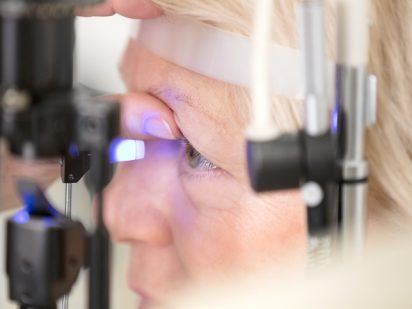Looking for a New Year’s resolution that yields big benefits with minimal effort? Resolve to call Trinity Health in the New Year to make an appointment for an eye exam.
Dilated eye exams are the only way to find out if you have glaucoma, the second leading cause of blindness in the US. The most common form of glaucoma, primary open-angle glaucoma, develops slowly and usually without any symptoms – no pain, discomfort, or blurry vision. Nearly 3 million people have glaucoma and half don’t know it, according to the National Eye Institute.
“Primary open angle glaucoma is typically a slowly progressive disease that affects each individual in a different way and at a different pace,” explained Trinity Health Ophthalmologist Darren Hill, MD. “While there are likely many factors that play into the disease, eye pressure is the one factor we know how to control. The research shows that if we can reduce eye pressure, we can usually slow the effects of the disease.”
There is a good reason why glaucoma is often described as a stealthy enemy of sight. “It is oftentimes a silent disease, meaning that you can have significant damage before you notice any of the effects,” Dr. Hill said.
Typically, your central vision is the last area of vision to be affected. This means that you can sustain severe and irreversible peripheral vision loss before you notice a significant change in your vision.”
The stealthy nature of glaucoma highlights the importance of getting an annual eye exam, whether you wear glasses or not. “If you have a family history of glaucoma and have not had a recent eye exam, I definitely recommend being seen.” Dr. Hill added.
Glaucoma is often described as a “plumbing problem” in the eye, like a clogged sink. At issue is the clear fluid (aqueous humor) that a healthy eye produces and that flows out through the eye’s drainage system. As long as your eyes’ fluid and drainage system is working properly, the inner pressure of the eye (intraocular pressure) stays within a normal range. However, if the system becomes clogged, fluid builds up and the intraocular pressure rises, which can damage the delicate optic nerve fibers and lead to vision loss.
There are several tests and exam findings that ophthalmologists follow to observe for progression of the disease, Dr. Hill said, adding, “Our team of optometrists and ophthalmologists are trained to screen for and treat glaucoma patients.” One diagnostic tool is Optical Coherence Tomography, which uses electromagnetic energy to map the surface of the optic nerve to provide more detailed information about the status of the many tiny individual nerve fibers that make up the optic nerve.
Treatment usually begins with topical eye drops, a laser procedure, or a combination of both. “There are several drops we use to accomplish this as well as an in-office procedure called selective laser trabeculoplasty (SLT),” Dr. Hill explained. “Surgical intervention becomes necessary when eye pressure is still uncontrolled on maximum drop therapy and testing reveals progression of the disease.”
Micro or minimally invasive glaucoma surgeries (MIGS) have improved glaucoma treatment in recent years. “All MIGS devices involve manipulation or implantation of devices in the iridocorneal angle (where the iris meets the cornea) inside the eye – this is where drainage of the internal fluid of the eye takes place. If flow can be improved through this system, a lower intraocular pressure is usually the result,” Dr. Hill said.
Two devices that have been approved by the US Food and Drug Administration within the last three years are the Hydrus Microstent and OMNI Surgical System. The Hydrus stent is a metallic stent approximately the size of a human eyelash that is inserted into the eye’s drainage system at the time of surgery. The OMNI device is a cannula or thin tube that is inserted through the drainage system. While being retracted, it releases a gel substance to dilate the drainage channels to further reduce pressure in the eye. No permanent device is left behind.
“The advantage of the OMNI device is that it is a repeatable procedure that can be performed as a standalone procedure (not combined with cataract surgery) and can also be used in severe stages of glaucoma,” Dr. Hill noted. “I have been combining the OMNI dilation procedure with the insertion of the Hydrus stent during cataract surgery to get the maximum reduction in intraocular pressure.”
The risk for glaucoma increases with age, affecting most commonly those 40 years of age and over. A person’s family – particularly African heritage and/or a positive family history of glaucoma in a first or second-degree relative – also plays a part. “Glaucoma is a disease that I like to catch early,” Dr. Hill said. “With the current technology available, we are unable to recover vision that is lost to glaucoma damage. However, we can dramatically slow the process.”
To make an appointment for an eye exam, please call Trinity Regional Eyecare – Minot at 701-857-3500 or Trinity Health Western Dakota in Williston.

